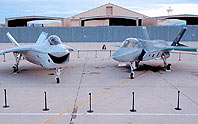|
From 1996 to 2001, Boeing and Lockheed Martin produced rival designs
and prototypes for the Joint Strike Fighter, a stealthy, affordable
combat plane intended for the 21st century needs of the U.S. Air
Force, Navy, and Marines. In "Battle of the X-Planes," NOVA goes
behind the scenes to show the world's newest fighter taking shape,
as Boeing and Lockheed Martin compete to win the largest contract in
military history.
NOVA's film crew was part of a small group allowed into both camps,
in the first-ever inside look at a Department of Defense weapons
competition. The team filmed inside installations where cameras have
never been allowed: the famous Skunk Works, where Lockheed Martin
designed the celebrated U-2 and SR-71 spy planes, and Boeing's
equally hush-hush Phantom Works.
The result is a fascinating glimpse of creative minds at work on one
of the most difficult and potentially lucrative aeronautical
projects ever undertaken, which is expected to earn the winner $200
billion, with the potential to earn up to $1 trillion over the life
of the project. Many aviation experts believe the Joint Strike
Fighter will be the last manned fighter built by the United States.
The program captures the clandestine world where amazing flying
machines are hatched amid freewheeling brainstorming, cost-conscious
compromising, and nervous speculation about what the other side has
up its sleeve. It also chronicles hair-raising moments inside the
cockpit, with a pilot's-eye view of the prototypes in flight.
The Joint Strike Fighter must meet the disparate needs of three
different services. For the Air Force: an inexpensive, multi-role
stealth fighter to replace the versatile but aging F-16. For the
Navy: everything the Air Force gets, but with the durability to
withstand operations at sea. For the Marines, the most daunting
specs of all: a short take-off and vertical landing (STOVL) fighter
to support Marine operations virtually anywhere. No other fighter
has ever had to serve so many different roles. The goal is to save
billions of dollars with a family of aircraft having an overwhelming
number of parts and systems in common.
But at the back of everyone's mind is the F-111, the Defense
Department's previous foray into fighter commonality, which is
widely regarded as a disaster. In the 1960s Defense Secretary Robert
McNamara ordered the Air Force and Navy to collaborate on a new
fighter-bomber. The severely compromised result left both services
dissatisfied. The F-111 was subsequently dropped by the Navy and put
into only limited operation by the Air Force. Pentagon managers are
determined that things will be different this time.
Lockheed Martin's prototype, the X-35, draws on the company's
experience designing the F-22 stealth fighter, which the X-35
resembles. By contrast, Boeing's X-32 has an unconventional
appearance that reflects its simpler approach to the STOVL problem.
While the Lockheed Martin X-35 has a traditional rear-mounted
engine, with a separate lift fan mounted in front for vertical
landings, the Boeing X-32 does the entire job with one engine. This
power plant is placed in the center of the aircraft, which gives the
X-32 its stubby, bat-like look.
The STOVL trials provide by far the most nail-biting moments of
flight-testing, because any flaws in performance can send the plane
plunging like a brick. But there are plenty of other dramatic
moments, as the X-Planes battle it out for leadership in the fighter
aircraft industry and the right to rule the skies wherever wars are
fought.


|

|
Head to head: Boeing's X-32 (left) and Lockheed Martin's
X-35, prototypes of the Joint Strike Fighter

|
|
|

